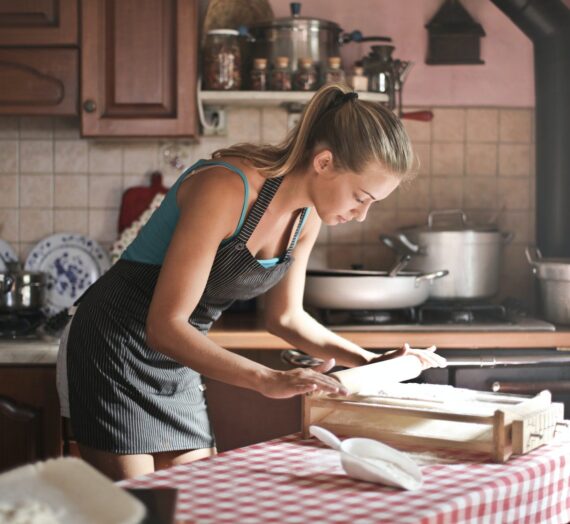FLOWERS TO FIGHT DISEASES: HOW BEDA HALLBERG BATTLED A PANDEMIC WITH MAYFLOWERS
How can you encourage people to donate money for a good cause? At the beginning of the 20th century, Beda Hallberg, a young Swedish woman, struggled with exactly this question. She wanted to raise funds for people suffering from tuberculosis – a small paper flower was the answer to her question.
Spreading diseases
Tuberculosis is a severe infectious disease that mostly affects the lungs. In the 19th and early 20th century, it was a widespread disease in Europe, especially among poorer people in urban areas.
After the Industrial Revolution, growing industries and the need for workers in factories led to mass migration to cities. Populations in cities and other centres of industrial production expanded, leading to catastrophic housing conditions for workers and their families. With many people living in small apartments or in the same rooms, it was difficult to prevent diseases from spreading. Tuberculosis thus led to 1 in 4 deaths in 19th century Europe.
Throughout Europe, different organisations and groups started to campaign against the spread of tuberculosis and in support of the urban poor. In Sweden, private initiatives first raised funds to send people to sanatoria and raise awareness around how to limit the spread of the disease.
Beda Hallberg
Beda Hallberg was an active member of Gothenburg’s charity movement.
Born in 1869, she was the youngest daughter of a captain and a farmer’s daughter. Her father left the family one year after her birth to emigrate to the US. Her mother and her four siblings lived in really simple conditions. Nevertheless, her mother tried to help poor and ill neighbours.
From the age of 12 on, Beda lived with her aunt in Gothenburg, where she later married a tobacco dealer in 1888. From the 1890s on, she volunteered for an organisation that took care of the poor in Gothenburg and visited families in their homes – where tuberculosis was a widespread issue. She realised soon that more money was needed to help them – and that traditional ways to raise funds – such as bazaars – were not enough.
In 1906, her daughter Margot came home with a little paper badge commemorating Gustavus Adolphus Day. That gave Beda the idea of selling small paper flower pins in exchange for a donation towards people suffering from tuberculosis in Gothenburg.
She founded a committee including Frigga Carlberg, a feminist social worker and writer, as well as the municipal physician K. J. Gezelius. Despite others doubting her idea, she ordered 100,000 blue-coloured paper flower pins and decided to sell them for 10 Öre each (around 50 cent today), so that nearly everyone could afford to buy one.
Her campaign became a tremendous success. Around 139,000 Mayflowers were sold on the 1 May 1907 in Gothenburg – exceeding even Beda’s expectations.
A local newspaper wrote the following:
‘The blue flower has won. The whole city celebrates it. You see it everywhere, wherever you come, on lapels and coats, scarves and shawls. Businessmen, civil servants, workers, old men and children, tram conductors, police officers, kayakers, drivers – they all carry the flower and feel that everyone is happy to be involved. It is the ideal of ideas: simple, enthusiastic and poignant.’
International aid
Other countries soon became interested in Beda Hallberg’s initiative.
Just two years later, Mayflowers had spread to all Nordic countries, and later to the Netherlands, Belgium, Russia, Germany, England and France. Even Algeria, Cuba, the USA and India started selling Mayflowers to support the fight against tuberculosis.
Children were at the focus of Beda Hallberg’s work.
From her visits to families’ homes, she knew that children were especially at risk to infect with tuberculosis and become severely ill. The money she raised with the campaign was hence used to send children to sanatoria and summer camps to protect them from the spread.
Building on her friendship with the founder of the Swedish scout movement, Ebbe Lieberath, she involved schoolchildren in selling the flowers, raising also their awareness for the conditions of poorer children.
Mayflower memories
Helene, who was born in Finland in 1941 and emigrated to Germany later in her life, shares her memories of selling Mayflowers during her childhood:
‘On the First of May, the scouts always had a parade all the way to the Cathedral. We had to wear the scout uniform all week, both when we were in school and when we sold the Mayflowers. And we had to sell at least ten – I always tried to sell them to my family and relatives. Later, I was always happy to have Mayflowers.’
Her granddaughter Flora, who grew up in Germany, received Mayflowers from relatives in Finland and recalls: ‘Mayflowers have an almost identity-establishing effect on me: wearing one abroad reminds me of this tradition of solidarity even outside of Finland’.
Mayflowers today
With the rise of vaccines and treatments and a rise in living quality in the second half of the 20th century, cases of tuberculosis decreased rapidly. In most countries, Mayflower initiatives disappeared.
Only the Nordic countries and Estonia still hold the tradition of selling and wearing Mayflowers dear. Today, the raised money is donated to poorer families and children in need.
Beda Hallberg was awarded the Illis quorum medal and the Order of Vasa by the Swedish king in 1914 and 1931. She became the chairwoman of the Swedish National Association against Tuberculosis in 1919 and travelled through the US for five months in 1931 to promote Mayflowers among Swedish emigrants.
She died in 1945, having become internationally known for her charity work.
Autor: Larissa Borc. Źródło artykułu: Europeana Foundation. Licencja CC BY-SA 4.0.
Definicje i przykłady zdań pochodzą ze słownika Cambridge Dictionary.
VOCABULARY
battle /ˈbæt.əl/ – to fight;
walczyć, toczyć bitwę
cause /kɔːz/ – a socially valuable principle that is strongly supported by some people;
cel
struggle /ˈstrʌɡ.əl/ – to experience difficulty and make a very great effort in order to do something;
zmagać, borykać się
disease /dɪˈziːz/ – (an) illness of people, animals, plants, etc., caused by infection or a failure of health rather than by an accident;
choroba
lung /lʌŋ/ – either of the two organs in the chest with which people and some animals breathe;
płuco
widespread /ˌwaɪdˈspred/ – existing or happening in many places and/or among many people;
rozległy, rozprzestrzeniony
expand /ɪkˈspænd/ – to increase in size, number, or importance, or to make something increase in this way;
rozrastać, powiększać się
prevent /prɪˈvent/ – to stop something from happening or someone from doing something;
powstrzymywać, zapobiegać
thus /ðʌs/ – in this way;
w ten sposób
spread /spred/ – the development or growth of something so that it covers a larger area or affects a larger number of people;
rozprzestrzenienie się
awareness /əˈweə.nəs/ – knowledge that something exists, or understanding of a situation or subject at the present time based on information or experience;
świadomość, znajomość, zdolność dostrzegania
sibling /ˈsɪb.lɪŋ/ – a brother or sister;
rodzeństwo
nevertheless /ˌnev.ə.ðəˈles/ – despite what has just been said or referred to;
niemniej jednak
dealer /ˈdiː.lər/ – a person who trades in something;
handlarz
issue /ˈɪʃ.uː/ – a subject or problem that people are thinking and talking about;
sprawa, problem
commemorate /kəˈmem.ə.reɪt/ – to remember officially and give respect to a great person or event, especially by a public ceremony or by making a statue or special building;
upamiętniać
pin /pɪn/ – a small thin piece of metal with a point at one end, especially used for temporarily holding pieces of cloth together; a decorative object, used as jewellery;
szpilka, broszka, agrafka
committee /kəˈmɪt.i/ – a small group of people chosen to represent a larger organization and either make decisions or collect information for it;
komitet
doubt /daʊt/ – to not feel certain or confident about something or to think that something is not probable;
wątpić
afford /əˈfɔːd/ – to be able to buy or do something because you have enough money or time;
być w stanie coś zrobić, pozwolić sobie na coś (finansowo, czasowo)
exceed /ɪkˈsiːd/ – to be greater than a number or amount, or to go past an allowed limit;
przekraczać
lapel /ləˈpel/ – a strip of cloth that is part of the front of a jacket or coat, it is joined to the collar and folded back onto the chest;
klapa (np. marynarki)
shawl /ʃɔːl/ – a large piece of cloth worn especially by women or girls over their shoulders and/or head;
szal, chusta
involved /ɪnˈvɒlvd/ – interested in or taking part in an activity or event;
zainteresowany, zaangażowany
poignant /ˈpɔɪ.njənt/ – causing or having a very sharp feeling of sadness;
wzruszający
aid /eɪd/ – help or support;
pomoc
initiative /ɪˈnɪʃ.ə.tɪv/ – a new plan or process to achieve something or solve a problem;
inicjatywa
at risk /æt rɪsk/ – in a dangerous situation;
w niebezpieczeństwie
severely /sɪˈvɪə.li/ – very seriously;
poważnie, ogromnie
hence /hens/ – therefore; that is the reason or explanation for;
więc, stąd, dlatego
establish /ɪˈstæb.lɪʃ/ – to discover or get proof of something;
ustalać, ustanawiać
vaccine /ˈvæk.siːn/ – a substance containing a virus or bacterium in a form that is not harmful, given to a person or animal to prevent them from getting the disease that the virus or bacterium causes;
szczepionka
treatment /ˈtriːt.mənt/ – the use of drugs, exercises, etc. to cure a person of an illness or injury;
leczenie
hold /həʊld/ – to cause to stay or continue in the same way as before;
utrzymywać, podtrzymywać
chairwoman /ˈtʃeəˌwʊm.ən/ – a woman who is in charge of a meeting, committee, or organization;
pani prezes




